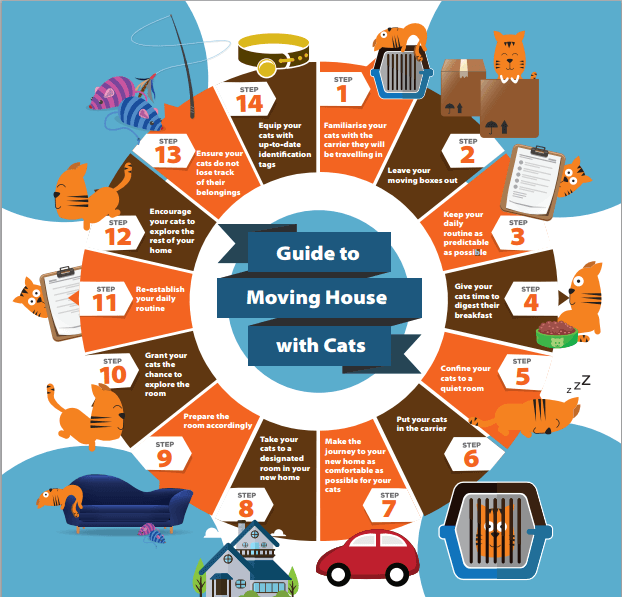
A Guide to Moving House with Cats
Moving home can be as stressful for cats as it is for you and your family. Most cats loathe change and if they could chose, they would much prefer to stay where they are already comfortable. Here are some tips to help you to make moving house with cats as easy as possible.
The pre-move preparations
1. Familiarise your cats with the carrier they will be travelling in
In the weeks before your move, let your cats get used to the sight of the carrier they will be travelling in by leaving it out with the door open. Once they have grown used to the presence of the carrier, start feeding them next to it and then, over time, put their food inside of it, near to the opening. Aim to gradually move the food towards the back of the carrier so that they have to step a little further inside each day. Eventually, place the food at the very back of the carrier so that your cats are tempted to venture inside without coercion.
2. Leave your moving boxes out
In addition to putting out the carrier, leave your moving boxes out a couple weeks of before you need to start packing so that your cats have time to get used to their presence. If your cats seem nervous while you are packing, it may be advisable to leave them in a quiet room, away from the activity. This is particularly important if you are concerned your cats may try to hide in the boxes.
3. Keep your daily routine as predictable as possible
While you are busy packing, try to keep your daily routine as stable as possible. Feed your cats at the same time as you would usually feed them or, if this is not possible, purchase feeders with timers to ensure that they are able to eat at the same time each day.
The move
4. Give your cats time to digest their breakfast
On the day of the move, feed your cats at least three hours before you are due to leave the house. This will help to reduce the risk of unpleasant accidents in the carrier during the trip to your new home.
5. Confine your cats to a quiet room
Before you start loading up the van, confine your cats to a quiet room in your home to prevent them from dashing out the door during the hustle and bustle of loading up the van. Put your cats’ possessions in this room and place a sign on the door so that everyone understands the importance of keeping the door to this room shut. Resist the urge to keep checking on your cats – they may try to escape when you open the door. Only enter the room when it is absolutely necessary for you to do so.
6. Put your cats in the carrier
Once you have packed up the van, enter the room your cats are in, calmly put them in their carrier and begin packing up their possessions. Leave the packing of their belongings as late as possible to minimise upset.
7. Make the journey to your new home as comfortable as possible for your cats
Before setting off in the car, lower your car windows an inch or two to help balance the air pressure inside of the car. Keeping your car cool and well ventilated will help your cats to feel more comfortable in their carrier.
The settling in process
8. Take your cats to a designated room in your new home
Once you have arrived at your new home, take your cats straight to a room that will provide them with the peace and quiet they require.
9. Prepare the room accordingly
Before granting them the chance to explore this room, set up essentials, such as food and water, so that they have access to these as required. Your cats may be freaked out by the move, and may soil your house in upset or in an attempt to mark out their territory. You may therefore want to cover the floor to make it easier for you to clean up after any accidents.
10. Grant your cats the chance to explore the room
Following letting your cats out of their carrier, place some treats around the room to encourage them to explore. Some cats are naturally curious and will investigate the room independently. Others are likely to be less inquisitive and, in all likelihood, perplexed by the change in their surroundings. If your cats seem nervous, it is best to let them observe their new surroundings at their own pace – paying them constant attention or forcing them to explore may make them more unsure.
11. Re-establish your daily routine
Regardless of the ease with which your cats adapt to their new surroundings, it is important that you quickly re-establish the same routines that your cats are accustomed to. Any deviation from the norm will confuse them even more.
12. Encourage your cats to explore the rest of your home
Once you have kept your cats in the one room for a few days, you should grant them access to the rest of your home, one room at a time. Be sure to supervise your cats during their exploration sessions. If necessary, offer them encouragement and treats as they begin to find their feet.
13. Ensure your cats do not lose track of their belongings
If you intend to house your cats in an alternative room to the one in which you have kept them during the flurry of unpacking, move your cats’ possessions a foot or so towards your preferred location each day. This will ensure that they do not lose track of their possessions.
14. Equip your cats with up-to-date identification tags
Your cats may try to return to your old home following a move. To prevent this, it may be necessary to keep them inside, or under close supervision if outside, for at least two weeks. It is advisable to equip your cats with identity tags with your new address on or, if they are microchipped, to update your details on the microchip database.
Making the move to your new home as stress-free as possible can have big benefits, helping to reduce the risk of fear-based behavioural changes, such as house soiling, hiding and escape attempts, in your cats. If you are moving house with cats and want the reassurance of a professional team catering for your move, the team here at Volition Removals can use their skills and experience to ensure that your move goes without a hitch. To find out more, please email office@volitionremovals.com.
Sources:
http://www.theguardian.com/direct-line-fixology/2014/sep/19/how-to-move-home-with-a-pet


